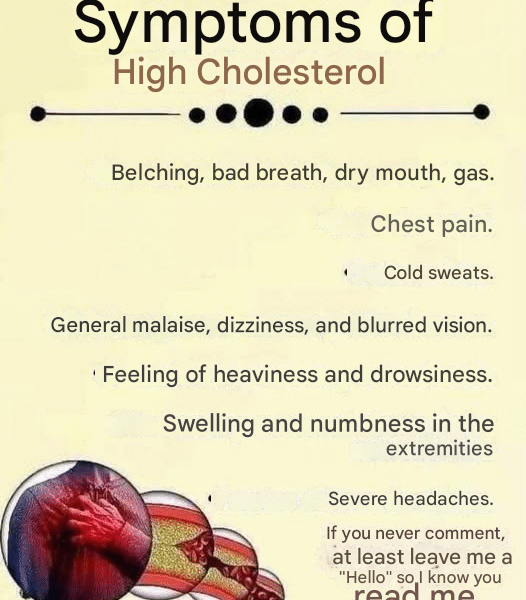Signs and Symptoms of High Cholesterol You Shouldn’t Ignore 

High cholesterol is often called a “silent killer” — and for good reason. It usually doesn’t cause any obvious symptoms, which makes it hard to detect until it leads to more serious health problems, like a heart attack or stroke.
But your body sometimes gives you subtle warning signs. Recognizing these early can help you take action before it’s too late.
Let’s explore the signs, symptoms, and hidden risks of high cholesterol — and how you can protect your heart naturally and effectively.
 What Is Cholesterol, and Why Does It Matter?
What Is Cholesterol, and Why Does It Matter?
Cholesterol is a fatty substance your body needs to build cells and hormones. But when there’s too much LDL (bad cholesterol) in your blood, it starts to stick to the walls of your arteries, forming plaque. Over time, this leads to narrowed arteries, poor circulation, and a much higher risk of heart disease, stroke, and high blood pressure.
 Signs and Symptoms That May Point to High Cholesterol
Signs and Symptoms That May Point to High Cholesterol
While high cholesterol usually has no direct symptoms, here are some possible warning signs and related conditions to watch for:
1. Chest Pain or Angina
Narrowed arteries from cholesterol buildup can limit blood flow to the heart, causing pressure or pain in the chest, especially during activity.
2. Xanthomas (Fatty Deposits on Skin)
These are yellowish bumps or nodules that can appear on the elbows, knees, hands, or around the eyes. They’re caused by excess cholesterol deposits under the skin.
3. Arcus Senilis (Gray Ring Around the Cornea)
A gray or white ring around the outer edge of the eye can appear in people with high cholesterol — especially those under 45. It’s often a sign of lipid imbalance.
4. Numbness or Tingling in Limbs
If plaque buildup is affecting circulation, you may experience poor blood flow to your arms and legs, leading to tingling, coldness, or numbness.
5. Shortness of Breath
Blocked arteries make it harder for the heart to pump blood efficiently, which can cause breathlessness, even with light activity.
6. Fatigue and Brain Fog
Restricted circulation and lower oxygen levels may lead to tiredness, poor focus, or dizziness — signs your body isn’t getting what it needs.
7. Sudden Health Events
Unfortunately, the first “symptom” for many people is a heart attack or stroke, which is why regular cholesterol screening is so important.
 When to Get Tested
When to Get Tested
Everyone over age 20 should get their cholesterol checked every 4–6 years — or more often if you have risk factors like:
- Family history of heart disease
- High blood pressure or diabetes
- Smoking
- Overweight or obesity
- Sedentary lifestyle
A simple blood test called a lipid panel will show your total cholesterol, LDL (bad), HDL (good), and triglyceride levels.
 Natural Ways to Lower Cholesterol
Natural Ways to Lower Cholesterol
If your levels are high, you can start improving them with these lifestyle changes:






 Final Thoughts
Final Thoughts
High cholesterol is silent — but dangerous. The best way to protect yourself is to know the warning signs, get tested regularly, and take action early.
Your heart, brain, and entire body will thank you for it.
If this article helped you, please like and share it with your friends and loved ones!
You never know — it might save someone’s life.





